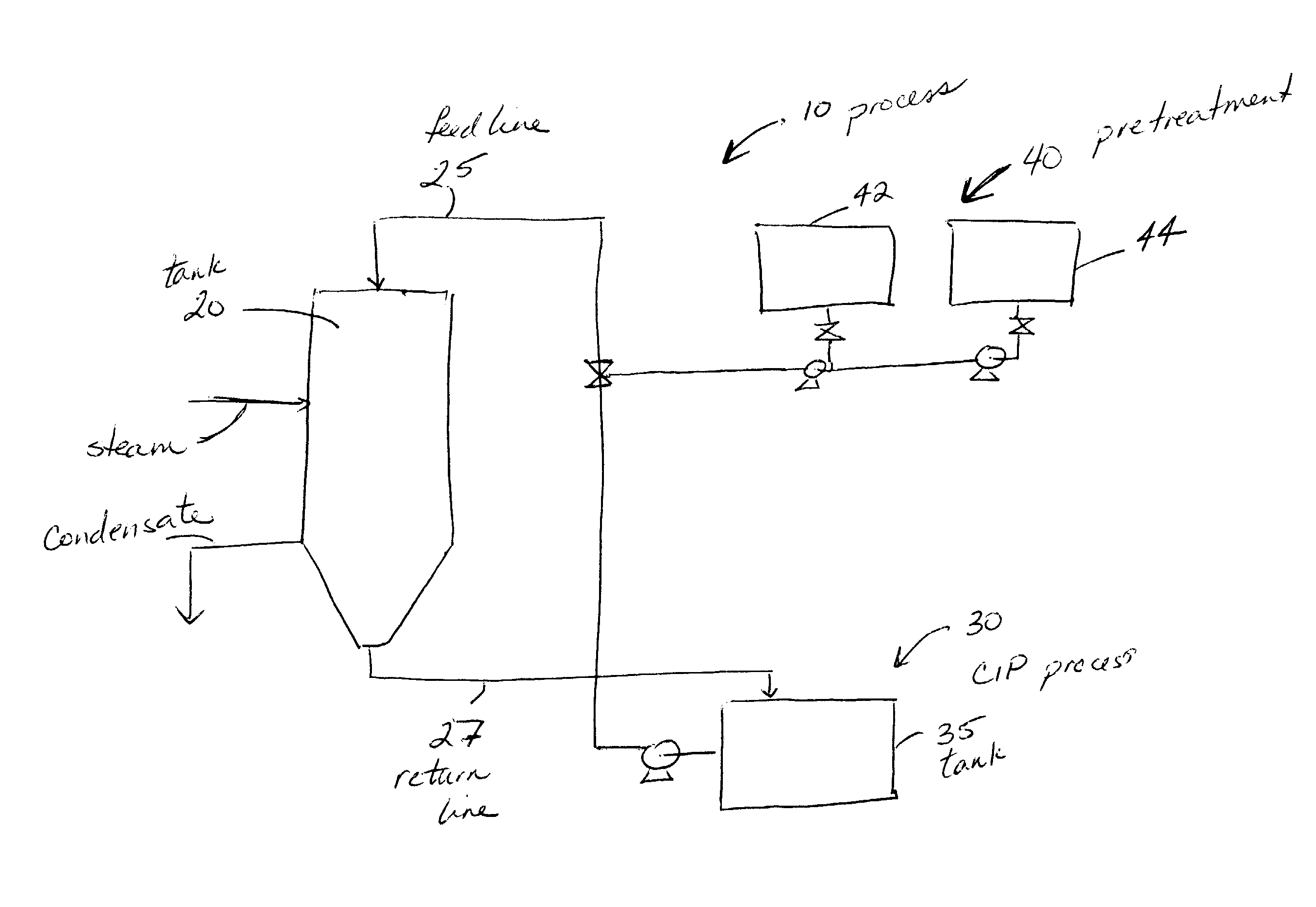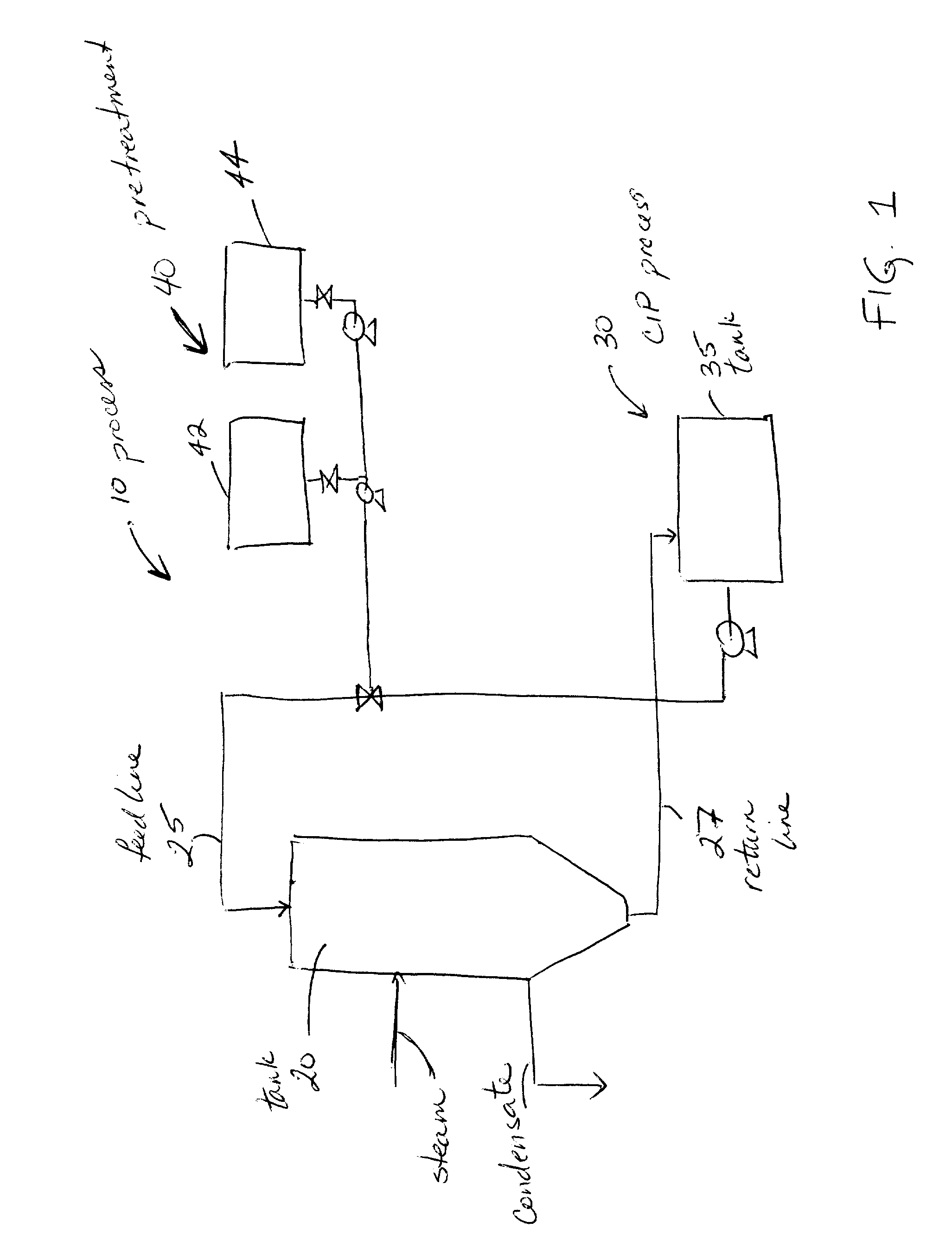Methods for cleaning industrial equipment with pre-treatment
a technology for industrial equipment and pre-treatment, which is applied in the direction of cleaning hollow articles, cleaning using liquids, detergent compounding agents, etc., can solve the problems of difficult soil removal of actual evaporators, difficult soil removal of carbohydrate soils, and common contamination of hard surfaces, so as to facilitate the removal of soil, improve the degree of softening of soil, and achieve effective results
- Summary
- Abstract
- Description
- Claims
- Application Information
AI Technical Summary
Benefits of technology
Problems solved by technology
Method used
Image
Examples
example 1
Test Procedure
[0074] Solid milk pellets were prepared by mixing 3 grams of dry milk power and 3 grams of soil. The resulting mix was pressed in a die for 30 seconds at 10,000 lb, and then more pressure was added to again apply 10,000 lb for 30 additional seconds. The pellets were placed in screens and immersed in the pre-treatment solutions, described below, for 5 minutes, removed, and then drained for 5 minutes. The screen and dried pellets were placed in a beaker of 0.5 wt-% NaOH at 120° F. (The test designated as “None” had no pre-treatment step; the test designated as “None *” had no pre-treatment step and used a 3.0% NaOH cleaning at 120° F., rather than the 0.5% NaOH). The beakers were placed on a hot plate set to 49° C. (approx. 120° F.) with large stir bars rotating at 350 rpm. After 30 minutes, the screen and pellets were removed from the cleaning solution and gently immersed in and removed from deionized water five times, and then dried overnight in a 50° C. oven. The res...
example 2
Test Procedure
[0084] Soiled stainless steel test panels, having soil on one side, were prepared by drying a mixture of mashed corn solids onto one side of the panel in an oven at 120° C. for 4 hours. The soiled panels were then cleaned as described below.
[0085] For Test (I), with the pre-treatment step, 800 grams of Pre-Treatment solution 5 were placed in a 1000 ml beaker. It had been determined that approximately 1 gram of the pre-treatment solution contacted and remained on the soiled panel. After a brief dip in the pre-treatment, the panels were hung for 5 minutes in ambient conditions. The dried panels were then placed in a 1000 ml beaker which had 750 g of 40° C. water with the soil side down. After 30 minutes, the panels were gently immersed in and removed from deionized water five times, and the panels were then dried. The results of the testing are below.
[0086] For Test (TI), the test panels were not pre-treated, but were cleaned in 750 g of 40° C. water with 1 g Pre-Trea...
example 3
[0090] Example 3 tested the effectiveness of various different pre-treatment and main wash chemistries on removing corn beer thin stillage syrup. For this test, the corn beer thin stillage syrup soil was prepared by weighing 3 inch by 5 inch stainless steel screens. A mixture of 85% corn beer thin stillage syrup and 15% deionized water was prepared and the screens were dipped in the mixture and set aside to drain the excess for 10 minutes. The screens were then baked at 125° C. for 2 hours. The screens were re-dipped and baked another 2 times for a total of 3 times. The final screens were weighed again. For cleaning, 1000 mL of the chemical cleaning solutions in Table 1 were heated to 180° F. The screens were inserted into the cleaning solution. A stir bar was in the cleaning solution and set at 400 rpm for the entire test (30 minutes). After 30 minutes, the screens were removed and allowed to dry before weighing. The percent soil removal was calculated using the following formula: ...
PUM
 Login to View More
Login to View More Abstract
Description
Claims
Application Information
 Login to View More
Login to View More - R&D
- Intellectual Property
- Life Sciences
- Materials
- Tech Scout
- Unparalleled Data Quality
- Higher Quality Content
- 60% Fewer Hallucinations
Browse by: Latest US Patents, China's latest patents, Technical Efficacy Thesaurus, Application Domain, Technology Topic, Popular Technical Reports.
© 2025 PatSnap. All rights reserved.Legal|Privacy policy|Modern Slavery Act Transparency Statement|Sitemap|About US| Contact US: help@patsnap.com



